April Davila's Blog, page 24
March 16, 2020
Smart Quotes in Scrivener

As I mentioned last Monday, I’ve been out on tour promoting my debut novel these past few weeks and haven’t had a ton of time. So I’m dropping another super simple little Scrivener tip on you this week for the #52WeeksOfScrivener series: smart quotes.
Smart Quotes vs. Straight Quotes
In case you’re not sure what I’m talking about, I found this handy visual aid:

I suppose this is a matter of taste, but in my experience agents and editors like to see smart quotes in a manuscript. They just look more elegant, more professions, more… smart.
That said, you can easily set Scrivener to use either. Just go to Edit -> Substitutions -> Smart Quotes. Check it if you want your quotes smart, uncheck it if you don’t.

Whole Document Changes
At some point in my editing, I realized I had some sections of my manuscript that used straight quotes and some that used smart. I suspect this was a remnant of having uploaded my project to Scrivener when it was half done.
But no worries. If you want to make sure your whole document is using your preferred quotes, just go to Edit -> Transformations -> Convert Quotes to Smart Quotes (or Straight Quotes).

Easy as pie. Don’t you wish everything is life could be this simple?
Next Week
Things should start to calm down a little next week and I’m planning to dive back in to some more juicy Scrivener tips. We still have a long way to go on this #52WeeksOfScrivener challenge. Stay tuned, follow on Twitter with #52WeeksOfScrivener, or sign up for my newsletter to get a weekly digest of all my posts.
And if you haven’t yet, order your copy of 142 Ostriches on Amazon. Katie Williams (author of Tell the Machine Goodnight) called it “A hurtling adventure of family intrigue helmed by a heroine for the ages.” You wouldn’t want to miss that, now, would you?
March 13, 2020
Irish Coffee

 This post is part of an extended series I’m writing about California.
This post is part of an extended series I’m writing about California. You can find out more on my Why California page.
In honor of the upcoming St. Patricks Day, we’re exploring the history of Irish Coffee in San Francisco…
Legend has it that in 1952 Jack Koeppler, then owner of the Buena Vista restaurant in San Francisco, decided to reproduce a whiskey drink that Pulitzer Prize-winning writer Stanton Delaplane (1907-1988) had tasted in Ireland years before.
The basic concept was a coffee and whiskey mixture with a cream layer floated on top, but Koeppler insisted that it be just right. After many sleepless, drunken nights they hit upon the perfect combination.
The official recipe, still in use today throughout the country, was four parts hot coffee and two parts Irish whiskey stirred with two sugar cubes. Then one and one half parts lightly whipped cream was delicately floated on top of the drink.
It quickly became a hit, and the Buena Vista has since served up an average of 2,000 cups of Irish Coffee EVERY DAY. And in case that wasn’t enough, in 2008 they set the record for making the world’s largest Irish Coffee.
In a specially made glass they mixed 10 litters of Tullamore Dew Irish whiskey, four pounds of sugar, ten gallons of coffee, and topped it off with two gallons of lightly whipped cream. By all accounts, it was delicious.
March 11, 2020
Thoughts on Author Readings
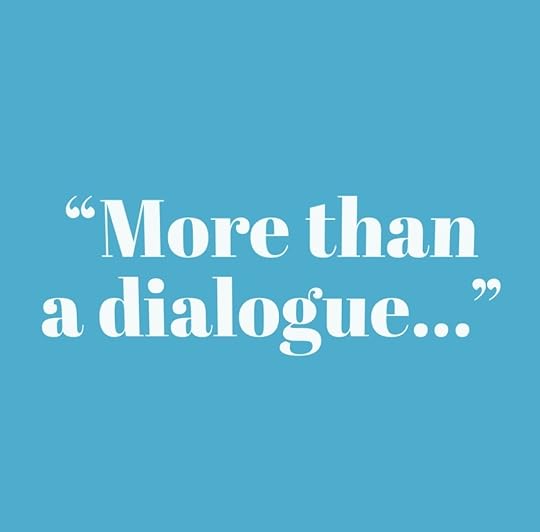

Sitting in my hotel room in San Antonio last week, taking a short rest from the AWP conference, I read an article in Poets & Writers called “Lessons From Last Night’s Reading,” penned by John Freeman.
Having been to dozens of readings in New York as a young man (and aspiring writer), Freeman had this to say:
Every single event holds the possibility that someone will leave changed – even the writer. The best writers on the road or on stage know that giving a reading or participating in an event isn’t simply a chance to say what they know. A good public event is more of a dialogue than that…
(March 2020 edition of Poets & Writers)
It was one of those fortuitous moments where the thing you need to read falls into your hands right when you need it. Because I was feeling worn out. I’d been away from my family for over a week, doing the book tour and then continuing on to AWP, I was exhausted and I was thinking to myself: why am I doing all of this?
For The Love Of Words
But reading Freeman’s piece reminded me of why I’ve always enjoyed going to readings. There is something magical that happens in the room, when you get to hear an author talk about the art/craft/mystery of writing. And now, after almost a decade of work, I get to participate as the author. What an awesome privilege.
That’s how I was feeling at my reading in Santa Rosa. I had finally found a place of comfort in front of the crowd and was able to engage in a conversation with everyone in the room, not just the moderator. Then, sadly, while I was at AWP, concerns around the Coronavirus ticked up and things started getting canceled.
Change of Plans
Check it out. This is what the conference schedule looked like on Saturday after I slashed out all the canceled sessions:

That night, my event in Seattle got postponed indefinitely. Portland followed immediately after. Back home I got a call from Scripps, saying they too were postponing all events…
But there is one event holding out. If you’re in the OC, you can still join me at a fundraiser for Soroptimist International. Wine, books, and a good cause. Check out my events page for more info.
Taking it Online
On the plus side, I am getting invites to video conference in with a few book clubs. As it turns out, “142 Ostriches” makes for excellent quarantine reading.
Also, my Otherppl podcast interview went live on Sunday. You can check that out here. It’s looking like online engagement may be the way to go for the next few months, until all this COVID19 business clears up.
Thanks again to everyone out there who came to my earlier readings. And for those I’m not going to see next week – hang in there, stay well, and I’ll let you know when we reschedule my readings.
March 9, 2020
Moving Things in Your Scrivener Binder

Here’s a sentence I’ve waited a long time to write: I’ve been on book tour lately, so things have been a little hectic. (smiley face)
In case you haven’t heard, my debut novel, 142 Ostriches, came out on February 25. Since then I’ve been traveling the west coast promoting it, and haven’t had a ton of time for other things.
So I’m keep it brief this week in the #52WeeksOfScrivener series, but that doesn’t mean I’m short-changing you. This little trick has actually saved me a ton of grief.
Easily Moving Files
One thing that used to frustrate me in Scrivener was that when I dragged files up or down in the binder, they tended to shift right and left as well, becoming more or less indented (some use the terms “child” and “parent” documents) and ruining the structure I had set up.
Well there is a super easy fix for that. Shift+Command+Arrow (or, as you can see below Edit -> Move -> Move Left, but really, the shortcut keystrokes are a lot easier).

Moving right or left will make the file a “parent” or “child” whereas moving up or down simply changes the order.
Easy as pie.
Next Week
I’ve got another quick trick for you next week, and then I think we’ll jump back into some beefier topics. Don’t forget to buy my book! Stay tuned, follow on Twitter with #52WeeksOfScrivener, or sign up for my newsletter to get a weekly digest of all my posts.
March 6, 2020
Dim Sum
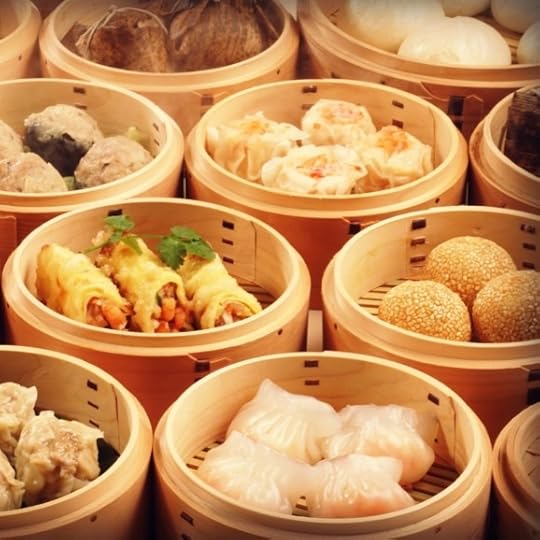
 This post is part of an extended series I’m writing about California.
This post is part of an extended series I’m writing about California. You can find out more on my Why California page.
Locals know that the best way to enjoy a lunchtime, dim sum feast is with friends. The restaurants tend to be noisy and high energy, and the dishes are intended for sharing.
For the uninitiated, the first thing to know about dim sum is that there will be tea. Dim sum originated as a snack during the Chinese teatime tradition, but here in California the snacks have definitely come to dominate.
Some restaurants have rolling trays from which diners can select bamboo baskets, filled with the treat of their choice, simply by pointing. Other establishments will supply pencils and menus with check boxes for their customers to mark which dishes they want served up.
Generally dim sum meals progress from lighter, steamed dishes such as dumplings and pork buns, to more exotic items including chicken feet or shrimp wrapped in bean curd skin. Deep fried dishes like egg rolls tend to come near the end of the meal, just before a dessert of custard tart or mango pudding.
As a local tradition dating back to San Francisco’s gold mining days, dim sum is a local experience definitely not to be missed.
March 4, 2020
The Book Tour Continues


It’s been just over a week since pub day and the start of my book tour for “142 Ostriches.” In eight days, I’ve done seven events, including the launch party. I’ve seen old friends and made some new ones, and done it all in the midst of a burgeoning pandemic.
I’m so grateful for everyone who has come out to the events. Because we all know it’s easier (and safer) to stay home. Of course it is. But you got in your cars, braved traffic, and fought for parking all to come out and support me and my book, this labor of love that I’ve spent the last decade pulling together. Thank you.
As I write this, I’m on a plane to San Antonio for the AWP conference and I’m not sure what to expect. On Monday there was serious talk of canceling the conference, in the face of growing concerns around Coronavirus, but then it was announced that it will go on. They have declared the conference a no handshake, no hugs event and have promised to put hand sanitizer dispensers all over the place.
Even so, I know a lot of people have decided not to go, and the conference organizers have offered a refund to anyone who would like one. There are certainly circumstances that would have me taking that refund (if, say, I lived with someone with a compromised immune system), but I’m healthy and strong and have a long-standing policy of not bowing to fear.
I also went through a lot of trouble to get a grant to cover the costs of this little excursion. I proposed in my application that, being in the first few weeks of my life as a published author, there were so many panels at AWP I needed to hear: how to build a career, how to survive a book tour, how to promote your work. This is a unique time in my life as a writer. I don’t want to miss it.
That said, I’m not dismissing the reality of Coronavirus. My pockets are full of hand sanitizer and zinc lozenges, but if the conference organizers felt it was safe to continue on, I’m willing to brave it.
Like everyone else in the country, I’ll be watching the news closely. I suppose if things take a dramatic turn I’ll squirrel myself away in my hotel room, but I’m hopeful that things are not all so bad as you might think when you scroll through your Facebook feed.
Stay tuned. I’ll let you know how it goes.
March 2, 2020
Label Colors in the Scrivener Binder
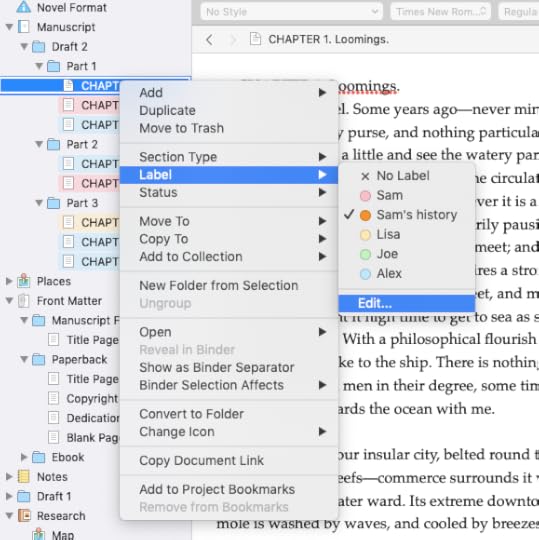
This week in the #52WeeksOfScrivener series I want to talk about adding color to your binder.
This is actually a follow up post to one I wrote back before the #52WeeksOfScrivener began. So let’s start there.
Color Coding Scrivener
In this post from last April, I walked you through the process of adding color to your folders, and we talked a little about why writers might want to use this functionality.
If you’re not already using color labels, I highly suggest you take a moment and review that post.
Basically, you can turn your binder from this:

To this:
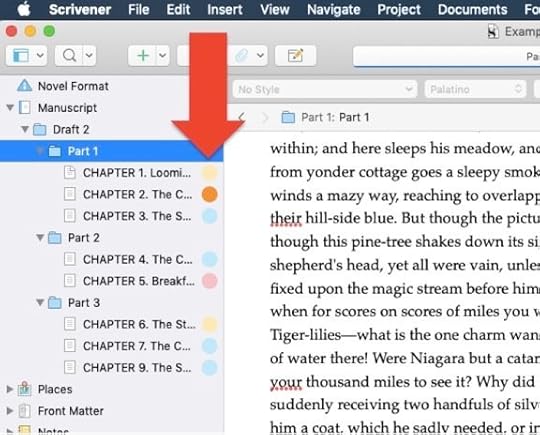
But there are a couple more things to know.
Dots Or Bars
You can change the way the color label appears in your binder. If those dot’s aren’t doing it for you, you can select Use Label Color In -> Use Full Width in Binder.

The result is something that looks like this:

Bolder Colors
When Scrivener launched 3.0 they set a lot of the default colors in the program to these soft pastels, but you’re not stuck with them.

Just control click on any of your documents. In the drop-down menu, go to Label -> Edit.

When you get this window, double click the little dot of color to change it to whatever works for you. You can also use this window to add labels or remove them (click the + and – signs at the bottom of the pop-up to do so).
And I’m pretty sure that’s everything I have to say about labels.
Next Week
In case you haven’t heard, my debut novel came out on February 25 (you can, and should, buy it on Amazon right now). Needless to say, it’s a pretty exciting time for me and I will admit to be pretty busy. So next week I’m keeping it short and sweet with a little organizational trick. Stay tuned, follow on Twitter with #52WeeksOfScrivener, or sign up for my newsletter to get a weekly digest of all my posts.
February 28, 2020
California Bungalow
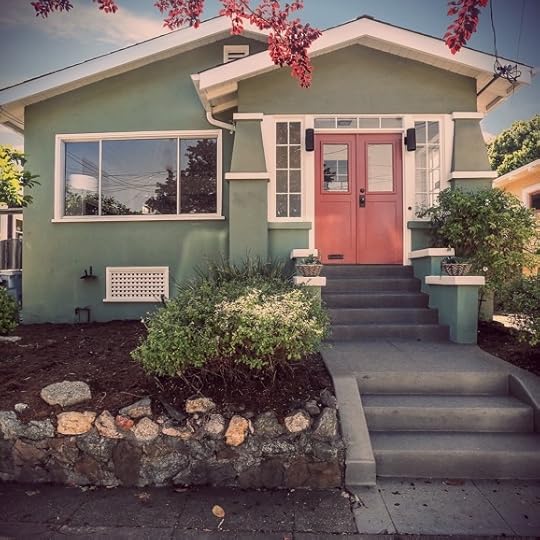
 This post is part of an extended series I’m writing about California.
This post is part of an extended series I’m writing about California. You can find out more on my Why California page.
The term “California Bungalow” was developed to describe a version Craftsman Style architecture that emerged in Northern California from 1890 to 1920.
They were charmingly simple homes, with open floor plans, full basements, large front porches and overhanging roofs supported by thick square columns. Most had built-in cabinetry and shelves.
Early designs focused on harmony with nature and quality craftsmanship, and are often seen as a backlash against industrialization. Ironically, by 1908 companies like Sears were offering the plans and materials to build California Bungalows in mail order kits, industrializing their construction and making them more accessible to the working class population of Northern California.
Generally falling between 800 and 1200 square feet, they are considered small by modern standards, but at the time they were symbols of prosperity and the rapidly growing suburbs of Berkeley and Oakland filled with bungalows during the first few decades of the 20th century.
Though the style was originally defined by single story construction, a two-story variation evolved in San Francisco, mostly in the city’s Inner Sunset district, to take advantage of the longer, narrower lot sizes.
February 26, 2020
Pub Day!
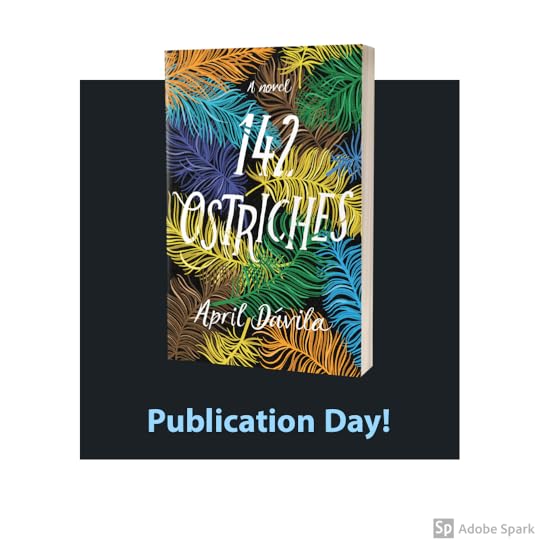
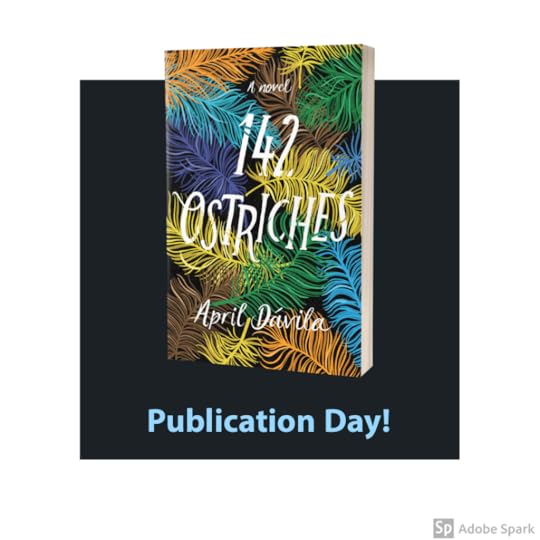
Yesterday morning I woke up and logged into my website to change all of the “pre-order your copy” links to read “order your copy.” Because it’s Pub Day! My book is officially published, out in the world, a thing people can buy and read and hold in their hands.
It’s been a long road. No joke. And all day yesterday felt like Christmas morning. Better even. I got flowers. I got texts all through the day as friends found their pre-ordered copies in their mailboxes. My sister-in-law came over to help me prep for the party. We all ate cupcakes for dinner.
I’m just overwhelmed by all the people who took a few moments out of their day to congratulate me on the book’s publication. I suppose it speaks to the fact that I’ve been working on this book for SO LONG.
Today I joined Janet Fitch on her Facebook Live broadcast to talk about organizing your research in Scrivener. Tonight I’m headed over to DIESEL Bookstore in Brentwood for a reading with Mark Sarvas. Tomorrow I’m at Skylight Books with Amy Meyerson. And in the spaces I’m trying to clean up from the party, keep blogging, put together my weekly LitWeekLA update, and answer all the thoughtful messages coming my way.
It’s a little hectic, but I’m loving it.
As soon as things calm down I’ll write some more in-depth posts about the logistics of all this, try to share some of the lessons I’m learning along the way (#1: when you have a hundred or so carefully decorated ostrich cupcakes in your car, you MUST drive slowly).
On Friday I head north for the rest of the book tour. You can check out a full list of events here.
February 24, 2020
Scrivener Front Matter

We’re continuing the #52WeeksOfScrivener series today with a little exploration of Front Matter.
One of the reasons I’ve put off this post is that the topic is bound to spark debates about publishing. Indie publishing vs. traditional publishing. Digital vs. print. So let’s all just agree to put the debates on hold – because however you’re planning to publish, Scrivener’s got you covered.
Front Matter
In short, your Front Matter includes the pages in your book that come before the story actually starts. If you click on the Front Matter icon in your binder, you’ll see 3 options:
Manuscript Format is for folks planning on submitting a manuscript to an agent or editor.Paperback is for authors planning to self-publish a hard copy of thier story.Ebook is, duh, for those planning to create a digital version of their book.
The Ebook template is super simple, so I’ll be focusing on the paperback and manuscript formats here.
Meta-Data
As you click around your front matter, you will see certain items bracketed with

These are your meta-data fields, meaning that you can actually fill in the information in your Preferences, and Scrivener will auto-fill that information for you as needed.
So take a minute and go to Scrivener -> Preferences -> General -> Author Information. Go ahead and fill in your information. You don’t even have to click save. Just close it when you’re done.

Now, when I print I can choose to include the front matter and Scrivener will format it to match which ever format I choose from a dropdown menu near the bottom of the compile menu:

Here’s what it looks like after exporting to Word:

Note that I never typed anything into the Front Matter section of Scrivener. This makes it very easy to print in different formats.
Project Title
Want to change the title of your manuscript? That’s an easy fix too.
Just close your document and rename it in your finder window. Scrivener automatically titles your document to match what you’ve called it in your files.
Or Don’t
Of course, you don’t have to use the meat-data functionality at all. If you KNOW your going to self-publish and you just want to go ahead and type your information into the Paperback Front Matter section, you totally can.
Just delete the tags (the bit) and write in your information manually.
You can also just export to Word, delete all the information that autofills, and write in your information that way.
Once again, this is the beauty of Scrivener. It gives you many options so you can go with whatever works best for you.
Next Week
On deck: using color labels in your Scrivener Binder. Stay tuned, follow on Twitter with #52WeeksOfScrivener, or sign up for my newsletter to get a weekly digest of all my posts.



